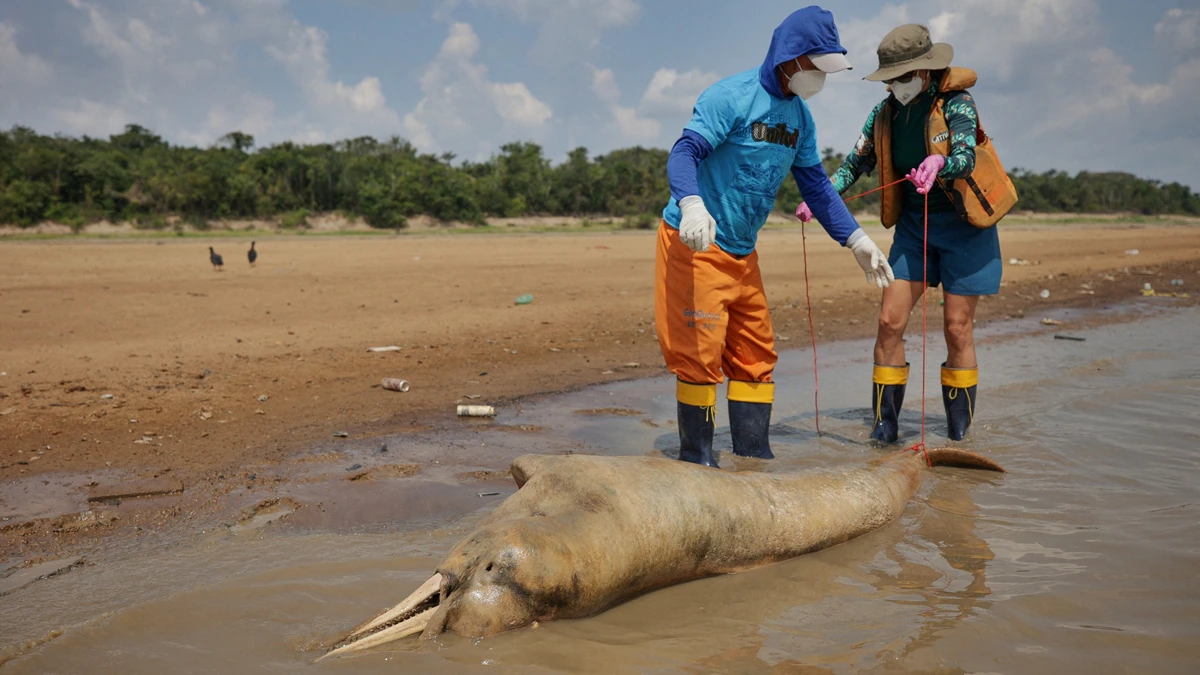Over the past few days, the remains of 120 river dolphins have been discovered floating in an Amazon River tributary. Experts believe that this was due to extreme heat and drought. According to researchers the portions of the river heated up to temperatures that are unbearable for dolphins because of low river levels during a severe drought. Due to low oxygen levels in the water, thousands of fish have lately perished in the rivers of the Amazon.
There are just a few number of freshwater dolphin species left in the world, and the Amazon river dolphins, many of which have a stunning pink colour, are a rare freshwater species found solely in the rivers of South America. Because of their populations’ slow reproduction rates, they are particularly sensitive to dangers.
Identifying the causes making the Dolphins dead-
When the water in Lake Tefé hit 39 degrees Celsius (102 degrees Fahrenheit) on Thursday, more than 10 degrees above the typical temperature for this time of year, at least 70 of the carcasses came to the surface.
On Monday, scientists and other specialists continued to rescue the dead mammals from a lake and perform autopsies on the carcasses of dead dolphins to identify the cause of death. The increase in dolphin mortality has not been definitively linked to heat waves and drought, according to scientists. The possibility of a bacterial infection killing the dolphins on a lake created by the River Tefé before it enters the Amazon is one of the possible explanations they are seeking to rule out.
Concerned specialists noted that after dropping for a few days, the water temperature increased once more on Sunday to 37 C (99 F). Environmental activists attribute the odd weather to climate change, which increases the likelihood and severity of droughts and hot waves. It’s unclear whether global warming is to blame for the present Amazon drought; El Nino and other causes are also at work.

Current situation and efforts taken-
Pink dolphins, known as “botos” in Brazil, account for almost eight out of every ten carcasses and may make up 10% of the species’ estimated population in Lake Tefé.
The boto and the grey river dolphin known as the “tucuxi” are listed as vulnerable species on the International Union for Conservation of Nature’s red list.The potential that the loss would rise above 10% could endanger the existence of the species in Lake Tefé, according to Marmontel, a researcher at the Mamiraua environmental institute who estimated that total number of the river dolphins in Tefe Lake to be around 1400.
Dolphins who are still alive in the lake are being rescued by the Chico Mendes Institute for Biodiversity Conservation in Brazil, which has dispatched veterinarians and aquatic animal specialists. They cannot be transferred to a river with colder water until a bacterial cause of the fatalities has been ruled out by researchers.
A situation of overall drought-
Nicson Marreira, the mayor of Tefe, a city of 60,000 people, claimed that the dry rivers prevented his administration from directly distributing food to some remote areas.
The drought, according to Ayan Fleischmann, the Mamirauá Institute’s geospatial coordinator, has significantly impacted the riverbank settlements in the Amazon region. Many towns are becoming isolated, he said, lacking access to clean water and the river, which serves as their primary mode of transportation.
According to Fleischmann, the temperature of the water increased from 32 degrees Celsius (89 degrees Fahrenheit) on Friday to about 38 degrees Celsius (100 degrees Fahrenheit) on Sunday. He stated that although the cause of the dolphin deaths is still being investigated, the high temperature is still the leading suspect.



